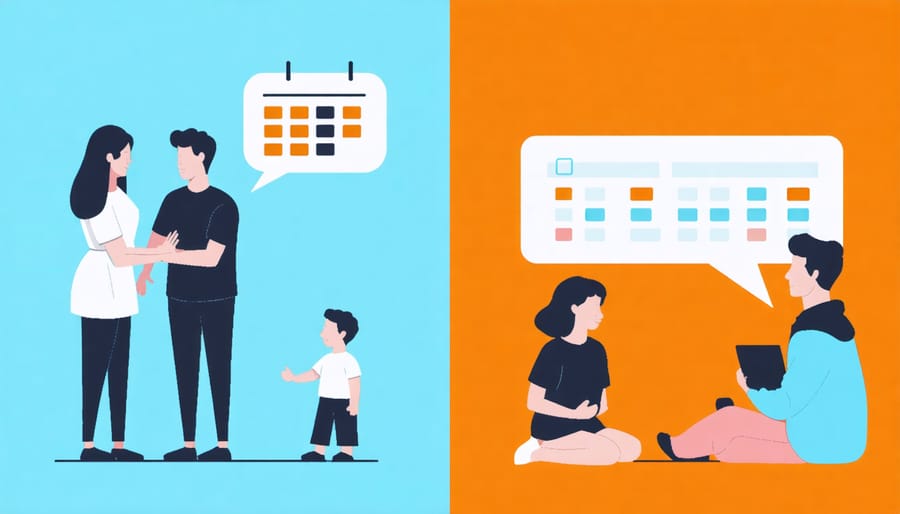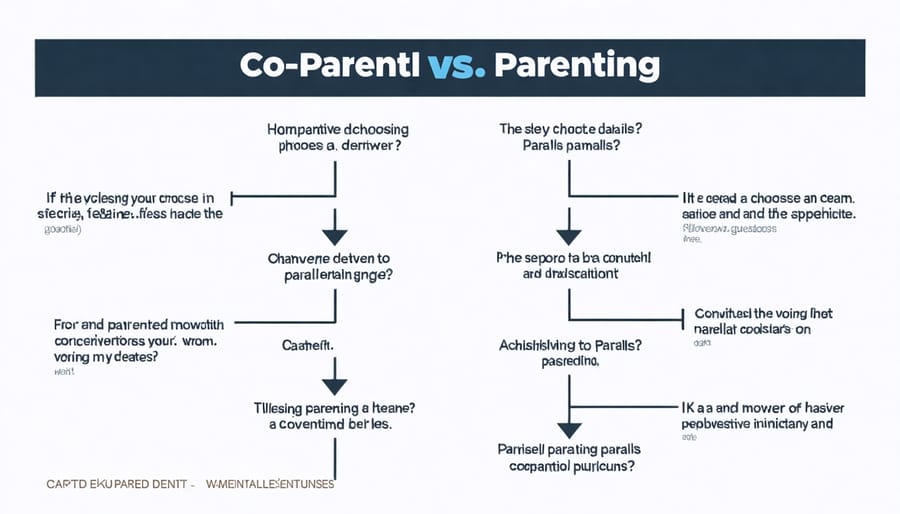When your co-parenting journey takes an unexpected turn, understanding the crucial difference between co-parenting and parallel parenting can transform your family’s path forward. While both approaches prioritize children’s wellbeing after separation, they serve distinctly different family dynamics and emotional landscapes.
Co-parenting flourishes when former partners maintain a respectful, collaborative relationship, working together on daily decisions and attending important events as a unified front. Parallel parenting, alternatively, offers a structured solution for high-conflict situations, allowing parents to disengage from each other while still providing stable, loving environments for their children.
Recent research shows that children adapt well to both approaches when consistently implemented. The key lies not in choosing the “perfect” method, but in selecting the style that best matches your family’s unique circumstances and emotional capabilities. Mental health professionals emphasize that reducing parental conflict, regardless of the chosen approach, remains the most significant factor in supporting children’s emotional wellbeing during and after separation.
Whether you’re just beginning this journey or reassessing your current arrangement, understanding these distinct parenting styles empowers you to make informed decisions that protect your children’s mental health while respecting your own emotional boundaries.
Understanding Co-Parenting and Parallel Parenting

What is Co-Parenting?
Co-parenting is a collaborative approach where separated or divorced parents work together as a team to raise their children, despite no longer being in a romantic relationship. This parenting style involves open communication, shared decision-making, and a unified front in matters concerning the children’s well-being.
In successful co-parenting relationships, both parents actively participate in their children’s daily lives, from attending school events to making important decisions about education, healthcare, and social activities. They maintain regular communication through various channels, such as phone calls, text messages, or co-parenting apps, and often share a common calendar to coordinate schedules.
Co-parenting works best when both parents can set aside their personal differences and maintain a respectful, business-like relationship focused solely on their children’s needs. This approach is particularly effective when parents have processed their emotional separation, can manage conflict constructively, and share similar values regarding child-rearing.
For example, co-parents might attend parent-teacher conferences together, coordinate on holiday arrangements, or jointly celebrate their child’s achievements. This unified approach helps children feel secure and supported, knowing both parents remain actively involved in their lives despite the separation.
What is Parallel Parenting?
Parallel parenting is a structured approach to raising children that minimizes direct contact between separated or divorced parents who struggle to communicate effectively. Unlike traditional co-parenting, this method allows both parents to disengage from each other while maintaining active roles in their children’s lives.
In this arrangement, parents operate independently within their own parenting time, making day-to-day decisions without consulting the other parent. Communication is typically limited to essential information about the child’s well-being and is often conducted through neutral methods like email, parenting apps, or written logs.
This approach becomes necessary in high-conflict situations, such as when parents experience ongoing hostility, struggle with emotional boundaries, or have a history of domestic violence. It can also be beneficial when there’s significant distrust, inability to compromise, or when one parent is dealing with addiction or mental health challenges.
Dr. Sarah Chen, a family therapist, explains, “Parallel parenting acts as a buffer, allowing children to maintain meaningful relationships with both parents while being protected from conflict. It’s like having two separate but equally important channels of love and support.”
Impact on Children’s Mental Health
Mental Health Benefits of Co-Parenting
When parents successfully navigate co-parenting, children experience numerous psychological benefits that contribute to their overall well-being and emotional development. Research consistently shows that children of co-parents demonstrate better emotional regulation, higher self-esteem, and stronger social skills compared to those in high-conflict parenting situations.
Dr. Sarah Chen, a child psychologist, notes, “Children thrive when they see their parents working together, even after separation. It provides them with a sense of security and stability that’s crucial for their emotional development.”
Co-parenting helps children maintain healthy relationships with both parents, reducing feelings of divided loyalty or guilt. They learn valuable life lessons about conflict resolution, compromise, and respectful communication by watching their parents model these behaviors. This often translates into better relationship skills in their own lives as they grow older.
Studies indicate that children in successful co-parenting arrangements show:
– Lower rates of anxiety and depression
– Better academic performance
– Stronger problem-solving abilities
– More positive peer relationships
– Greater emotional resilience
Many children express relief when their parents can effectively co-parent. As 12-year-old Jake shares, “It makes me happy knowing my mom and dad can still talk and make decisions together about important stuff in my life. I don’t feel stuck in the middle anymore.”
The consistent support and unified approach in co-parenting create a protective emotional environment where children can focus on their own growth and development rather than managing adult conflicts.

When Parallel Parenting Protects Mental Health
While co-parenting is often considered ideal, there are situations where parallel parenting becomes crucial for protecting everyone’s mental health, especially the children’s. High-conflict divorces or separations, ongoing hostility between parents, or cases involving emotional abuse can create toxic environments that harm children’s emotional well-being.
Dr. Sarah Chen, a family therapist, shares: “When children witness constant conflict between parents trying to co-parent, they often experience anxiety, depression, and feelings of guilt. Parallel parenting can provide the emotional distance needed for tensions to settle.”
Parallel parenting becomes particularly beneficial when:
– One parent struggles with controlling behaviors
– Communication between parents triggers emotional distress
– There’s a history of domestic violence or harassment
– Children show signs of stress during parent interactions
– One parent consistently undermines the other’s authority
Consider Maria’s experience: “After trying to co-parent for a year, every interaction with my ex-husband left me anxious and unable to focus on our daughter. Switching to parallel parenting helped me become a more present mother, and my daughter stopped walking on eggshells around us.”
The emotional buffer that parallel parenting creates allows children to maintain healthy relationships with both parents without being caught in the middle of adult conflicts. It provides a structured environment where they can feel secure and loved, free from the burden of managing their parents’ relationship.
Making the Right Choice for Your Family
Assessment Questions to Consider
Before deciding between co-parenting and parallel parenting, consider these thoughtful questions to assess your situation:
Communication Assessment:
• Can you maintain respectful conversations with your ex-partner?
• Do discussions about your children remain focused and constructive?
• Are you able to manage emotions during interactions?
Conflict Evaluation:
• How severe is the conflict between you and your ex-partner?
• Can you be in the same room without tension affecting your children?
• Is there a history of domestic violence or abuse?
Child-Focused Questions:
• How do your children react when both parents are present?
• Are they showing signs of stress during transitions?
• What parenting arrangement would best support their emotional security?
Personal Readiness:
• Are you emotionally ready for regular interaction with your ex-partner?
• Have you worked on building parental resilience through this transition?
• Can you separate your personal feelings from parenting decisions?
Support System:
• Do you have emotional support from family, friends, or professionals?
• Are there trusted mediators available if needed?
• Have you considered seeking family counseling?
Remember, there’s no wrong answer – the best choice is what works for your family’s unique situation while prioritizing your children’s well-being.

Red Flags and Warning Signs
Several warning signs may indicate that parallel parenting is a more appropriate choice than co-parenting. If you notice ongoing conflicts, verbal aggression, or toxic family patterns during interactions with your ex-partner, this suggests that maintaining distance might be healthier for everyone involved.
Red flags that favor parallel parenting include:
– Inability to communicate without arguing
– Ongoing feelings of anger or resentment
– History of emotional manipulation
– Refusing to respect boundaries
– Using children to relay messages
– Consistently undermining each other’s parenting decisions
Conversely, signs that support choosing co-parenting include:
– Ability to set aside personal differences
– Mutual respect despite the separation
– Willingness to compromise
– Consistent and calm communication
– Shared commitment to children’s well-being
– Ability to attend children’s events together
Remember that these situations aren’t always permanent. Some parents may start with parallel parenting and gradually transition to co-parenting as emotions settle and communication improves. The key is choosing an approach that minimizes conflict exposure for your children while ensuring their needs are met.
Implementing Your Chosen Approach
Setting Up Successful Co-Parenting
Establishing successful co-parenting strategies requires commitment, clear communication, and a child-centered approach. Here’s how to build a strong foundation:
Start by creating a detailed parenting plan that outlines schedules, responsibilities, and decision-making processes. This plan should be flexible enough to accommodate changes while providing structure and consistency for your children.
Maintain open, respectful communication with your co-parent. Use neutral language and focus on child-related matters only. Many parents find success using dedicated co-parenting apps or shared calendars to coordinate schedules and share important information about their children’s activities and needs.
Establish consistent rules and routines across both households. While small differences are natural, maintaining similar expectations for behavior, homework, and daily routines helps children feel secure and reduces confusion.
Keep your children’s needs at the center of every decision. Avoid speaking negatively about your co-parent in front of the children, and support their relationship with the other parent. Remember that children benefit from having healthy relationships with both parents.
Practice emotional self-regulation and seek support when needed. Working with a family therapist can help navigate challenging situations and provide tools for effective communication. Join support groups to connect with others in similar situations and share experiences.
Make transitions between homes smooth and positive. Create predictable routines around exchanges and help children prepare for these transitions. Keep important items like favorite toys or comfort objects accessible in both homes.
Celebrate your children’s achievements together when possible, and coordinate on special occasions like birthdays and holidays. This shows your children that despite the separation, you’re both committed to their happiness and well-being.
Establishing Effective Parallel Parenting
To establish effective parallel parenting, clear boundaries and consistent guidelines are essential for both parents and children. Start by creating a detailed parenting plan that outlines schedules, responsibilities, and communication protocols. This plan should be specific about drop-off and pick-up times, holiday arrangements, and how to handle schedule changes.
Communication should be business-like and focused solely on children’s needs. Many successful parallel parents use email or dedicated co-parenting apps to maintain records and minimize direct contact. Keep messages brief, factual, and emotion-free, addressing only necessary information about education, health, or scheduling.
Set firm boundaries by limiting interactions during transitions. Some parents find it helpful to conduct exchanges at neutral locations or through a third party. Create separate events for important occasions like school activities or medical appointments to avoid unnecessary contact while ensuring both parents remain involved in their children’s lives.
Documentation is crucial – maintain detailed records of agreements, communications, and schedule changes. This helps prevent misunderstandings and provides reference points when needed. Consider using a shared online calendar that both parents can access without direct interaction.
Establish clear protocols for emergencies and unexpected situations. Define what constitutes an emergency and outline appropriate response procedures. Include contact information for both parents and relevant caregivers, medical providers, and school personnel.
Remember that flexibility within structure can be beneficial. While maintaining boundaries, allow room for occasional adjustments when they serve the child’s best interests. As children grow and circumstances change, be prepared to revisit and modify the parenting plan while maintaining the parallel approach.
Professional support, such as family therapists or mediators, can help establish and maintain these boundaries, especially during the initial transition to parallel parenting.
Choosing between co-parenting and parallel parenting is a deeply personal decision that depends on your unique family dynamics and circumstances. Both approaches can be effective when implemented thoughtfully and with your child’s best interests at heart. The key is to honestly assess your situation, including your ability to communicate with your ex-partner and the level of conflict in your relationship.
Remember that your choice isn’t permanent – many families start with parallel parenting during high-conflict periods and gradually transition to co-parenting as emotions settle and communication improves. The most important factor is creating a stable, nurturing environment where your child feels secure and loved.
Whatever approach you choose, prioritize your child’s emotional well-being by keeping conflict away from them, maintaining consistent routines, and never speaking negatively about the other parent. Consider seeking support from family therapists or parenting coordinators who can help guide your decision and implementation.
Your child’s mental health thrives when they feel supported by both parents, regardless of the parenting structure you choose. Focus on creating a peaceful environment that allows your child to maintain healthy relationships with both parents while feeling free to express love for each of you without guilt or conflict.
By remaining flexible, child-focused, and committed to your parenting responsibilities, you can help your child navigate this transition successfully and grow into a well-adjusted, emotionally healthy individual.







